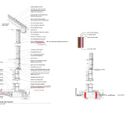Wall detail for new build
So after talking to a few people in the local industry and having them tell me ” you don’t need that down here” and ” we don’t do things that way down here” I am looking for more opinions from the experts. So we are building our retirement home here in Macon, NC. 3-1/2 hours inland from coast. My architect and I have been working on my house plans now for almost 1 year getting all the details right and now I have a question. So on the wall detail Here is what I have , I had planned to use zip system r-sheathing but because of price and engineers hesitance because of foam to studs vs wood to studs I no longer plan to. So Now I plan to use either 7/16″ osb or 1/2″ or thicker plywood with 2″ rigid foam board with taped or seam sealed seams on top followed by board and batten siding. My question is this, should I or do I need to put a rain shield like a water and ice shield between the osb/plywood and the rigid foam board? will it damage the sheathing faster if I do? the inside insulation will be 2″ closed cell spray foam followed up by 3.5″ of rock-wool insulation in a 2×6 stud wall. Also anything wrong with my wall detail that sticks out that would cause problems. this house will have both conditioned attic and basement as well.
GBA Detail Library
A collection of one thousand construction details organized by climate and house part










Replies
"do I need to put a rain shield like a water and ice shield between the osb/plywood and the rigid foam board?"
Yes, It's common to include a WRB behind rigid foam directly on the sheathing. Detailed properly, rigid foam could serve as WRB but I'm skeptical of that approach because rigid foams can shrink over time. You also want an air barrier at the sheathing plane, so the WRB can serve that purpose too. Closed cell foam between the studs isn't the greatest air barrier because it can similarly shrink and gap from the studs after years of moisture cycling. I would opt for 5.5" mineral wool instead.
I'm seeing several discontinuities in the air barrier, one at the eave, the other at the top of foundation wall. Have your architect address those. Often these are the locations where there are few other options to transition other than spray foam.
Make sure that the wall complies with the recommendations in Table 2 A or B here.
Best to avoid more low perm layers than are required by the above. Ie, consider spray foam or exterior foam, but not both. Avoid high GWP XPS - I'd use unfaced EPS. 1.5" thick exterior foam is sufficient moisture wise and might be significantly easier.
I'd tape the sheathing and use a lapped WRB. If it's not free to drain, then use DrainWrap. A rainscreen gap is beneficial. Always verify air sealing with testing.